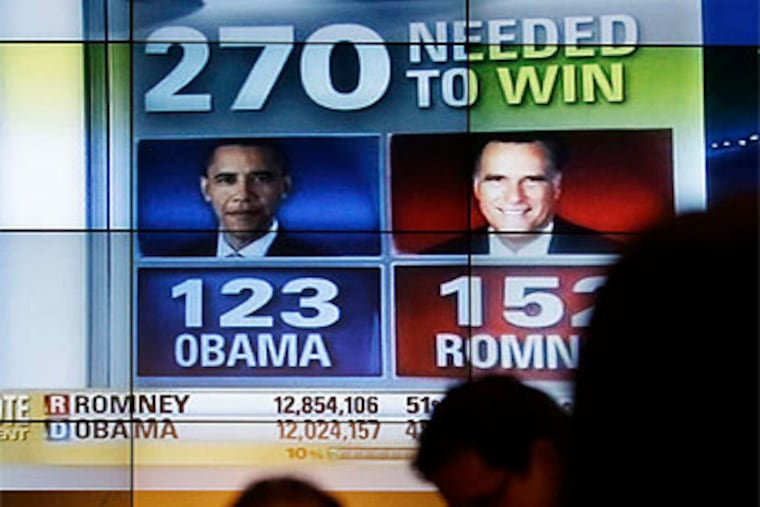Jeff Gelles: The science of predicting election's winner
Sam Wang spent Tuesday evening at an election-night party near his South Jersey home. But unlike other guests, he didn't find much suspense in the flashing red and blue maps or the continually shifting numbers from around the country. That's because he pretty much knew what to expect beforehand.

Sam Wang spent Tuesday evening at an election-night party near his South Jersey home. But unlike other guests, he didn't find much suspense in the flashing red and blue maps or the continually shifting numbers from around the country. That's because he pretty much knew what to expect beforehand.
A Princeton University neuroscientist, the 45-year-old Wang doubles every four years as an election forecaster. His success this year, with that of some better-known counterparts, offers evidence for a proposition that seems to drive pundits and political pros crazy: that computer models and a technique called meta-analysis can essentially turn the art of predicting votes into a science.
On the morning of Election Day, for instance, Wang predicted that President Obama would win the overall popular vote by 2.2 percent - a number that landed just a fraction of a percentage point from the provisional final count, in which Obama beat GOP nominee Mitt Romney by about 2.4 percent.
Wang proved uncannily prescient in his election-eve predictions of the nation's closest Senate contests, too. Fans of his Princeton Election Consortium blog (http://election.princeton.edu) could have amazed friends by predicting that Elizabeth Warren, Claire McCaskill, Tammy Baldwin, and Heidi Heitkamp would nearly run the table for Democratic women by winning seats, then adding that Shelley Berkley seemed destined to fall short in Nevada.
And Wang called at least 50 of the 51 state-level presidential counts. His only evident failure: Florida, a state he called as a statistical tie before digging into his data to seek evidence for a tiebreaker, then calling it for Romney.
On Wednesday, Obama held a tiny lead in Florida in a race the news media still considered too close to call. "It looks like I lost that coin toss," Wang said cheerfully.
I caught up with Wang after Tuesday's voting to ask about the statistical science and technology behind his modeling, and how he sees the recent transformation in election predicting, a field in which a small number of "young nerds," as Wang describes himself and his counterparts, are suddenly having a dramatic impact.
'Messy signals'
Much of the attention goes to Nate Silver, a baseball analytics whiz who jumped into election forecasting in time for the 2008 election, and whose FiveThirtyEight blog is now part of the New York Times' online empire. Wang got started four years earlier, as a sideline to his day job as a molecular biologist and researcher at the Princeton Neuroscience Institute.
Every few years, like cicadas, "this hobby descends on me during the election," Wang laughed when I asked him how the two jobs fit together. But the truth is, it's more than an odd hobby or fascination with an unrelated field. Wang sees clear parallels with neuroscience, which he describes as "a frontier discipline where we are constantly having to extract meaning from data points that are hard to interpret one at a time."
The minds of voters - and the way that intention, as discerned by pollsters, predicts their Election Day actions - are similarly full of "messy signals," he says. But not so messy that he can't reliably nail most of his predictions.
Wang was so confident this year, in fact, that he made blogosphere headlines by questioning the Romney camp's motives for last-minute forays into Pennsylvania and Minnesota.
"If he wins either of those states I will eat a bug," Wang promised in his blog last week. "Ohio . . . a really big bug. And yes, I will post a photo."
Whew
A relieved Wang posted Wednesday that "I will not have to eat a bug." But all snideness aside, Wang's point is a basic defense of statistical methodology - and of what statisticians sometimes call "the power of large numbers."
"The core part of what I do is not that complicated. It's simply to use robust statistics to figure out who's ahead in every state, and to use probability modeling" to estimate the relative likelihood of a number of possible outcomes.
True, it's a very large number - about 2.3 quadrillion - which means that computers are essential to the work he does. But the basic input comes from a source anyone could use: the results of public polls, sometimes as many as several dozen a day, that come out during campaigns.
Wang doesn't judge polls or adjust their results - even though adjusting samples for factors such as demographics is a basic part of polling. He simply aggregates the results, much as medical researchers do in meta-analyses that combine smaller studies to produce better predictions. To eliminate noise from outlier polls, he focuses on medians, not averages.
Ironically, it's the noise that got Wang interested in the field - he wants to eliminate it. If he gets his way, the horse-race aspect of politics will become plain and obvious - just another thing we take note of while focusing on the issues that actually matter.
at 215-854-2776 or jgelles@phillynews.com.